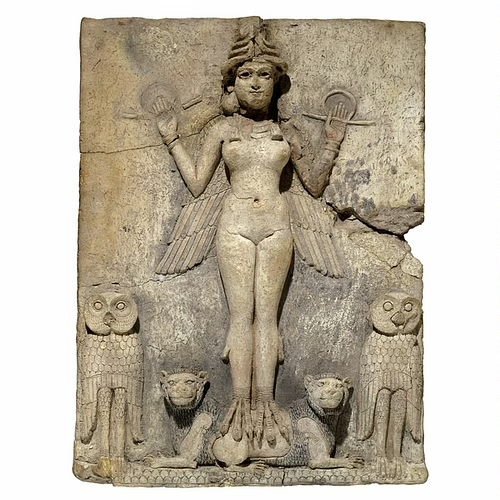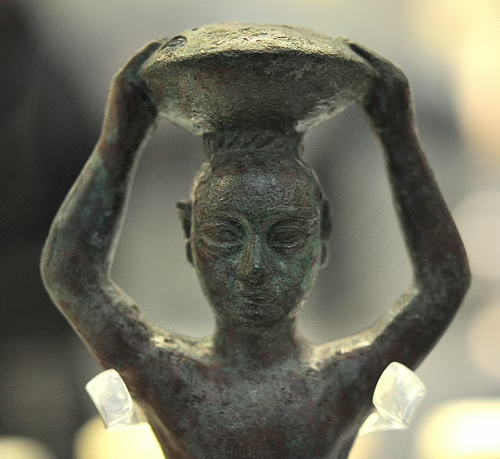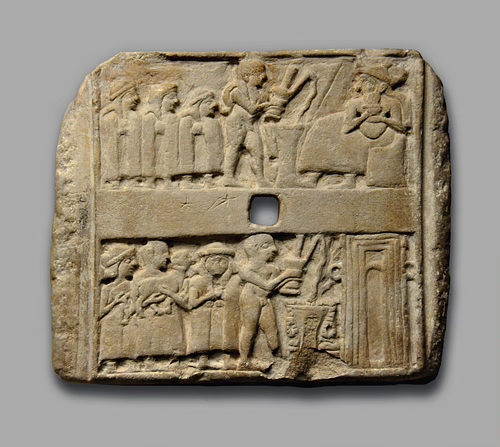3.4: Mesopotamian Religion
- Page ID
- 103502
https://www.worldhistory.org/Mesopotamian_Religion/
In ancient Mesopotamia, the meaning of life was for one to live in concert with the gods. Humans were created as co-laborers with their gods to hold off the forces of chaos and to keep the community running smoothly.

Queen of the Night, Old Babylon Trustees of the British Museum (Copyright)
Mesopotamian Creation Myth
According to the Mesopotamian creation myth, the Enuma Elish, (meaning,'When on High') life began after an epic struggle between the elder gods and the younger. In the beginning there was only water swirling in chaos and undifferentiated between fresh and bitter. These waters separated into two distinct principles: the male principle, Apsu, which was fresh water and the female principle, Tiamat, salt water. From the union of these two principles all the other gods came into being.
These younger gods were so loud in their daily concourse with each other that they came to annoy the elders, especially Apsu and, on the advice of his Vizier, he decided to kill them. Tiamat, however, was shocked at Apsu's plot and warned one of her sons, Ea, the god of wisdom and intelligence. With the help of his brothers and sisters, Ea put Apsu to sleep and then killed him. Out of the corpse of Apsu, Ea created the earth and built his home (though, in later myths 'the Apsu' came to mean the watery home of the gods or the realm of the gods).
Tiamat, upset now over Apsu's death, raised the forces of chaos to destroy her children herself. Ea and his siblings fought against Tiamat and her allies, her champion, Quingu, the forces of chaos and Tiamat's creatures, without success until, from among them, rose the great storm god Marduk. Marduk swore he would defeat Tiamat if the gods would proclaim him their king. This agreed to, he entered into battle with Tiamat, killed her and, from her body, created the sky. He then continued on with the act of creation to make human beings from the remains of Quingu as help-mates to the gods.
According to historian D. Brendan Nagle:
Despite the gods' apparent victory, there was no guarantee that the forces of chaos might not recover their strength and overturn the orderly creation of the gods. Gods and humans alike were involved in the perpetual struggle to restrain the powers of chaos, and they each had their own role to play in this dramatic battle. The responsibility of the dwellers of Mesopotamian cities was to provide the gods with everything they needed to run the world.
Cities, Temples, and Gods
The gods, in turn, took care of their human helpers in every aspect of their lives. From the most serious concerns of praying for continued health and prosperity to the simplest, the lives of the Mesopotamians revolved around their gods and so, naturally, the homes of the gods on earth: the temples.
Every city had, as its center, the temple of the patron god of that city. The most famous holy city was Nippur where the god Enlil legitimized the rule of kings and presided over pacts. So important a center was Nippur that it survived, intact, into the Christian and then the Muslim periods and continued, until 800 CE, as an important religious center for those new faiths.
THE MOST FAMOUS HOLY CITY WAS NIPPUR WHERE THE GOD ENLIL LEGITIMIZED THE RULE OF KINGS.
The patron god or goddess of a city had the largest temple in the city, but there were smaller temples and shrines to other gods throughout. The god of a particular temple was thought to literally inhabit that building and most temples were designed with three rooms, all heavily ornamented, the innermost being the room of the god or goddess where that deity resided in the form of his or her statue. Every day the priests of the temple were required to tend to the needs of the god. According to Nagle:
“Daily, to the sound of music, hymns, and prayers, the god was washed, clothed, perfumed, fed and entertained by minstrels and dancers. In clouds of incense, meals of bread, cakes, fruit and honey were set before the deity, along with offerings of beer, wine and water…On feast days the statues of the deities were taken in solemn procession through the courtyard [and] the streets of the city accompanied by singing and dancing.”
The gods of every city were accorded this respect and, it was believed, they needed to make the rounds of the city at least once a year in the same way a good ruler would ride out from his palace to inspect his city regularly.

Foundation Figurine of Ur-Nammu Osama Shukir Muhammed Amin (CC BY-NC-SA)
The gods could even visit each other on occasion as in the case of the god Nabu whose statue was carried once a year from Borsippa to Babylon to visit his father Marduk. Marduk, himself, was honored greatly in this same way at the New Year Festival in Babylon when his statue was carried out of the temple, through the city, and to a special little house outside the city walls where he could relax and enjoy some different scenery. Throughout this procession, the people would chant the Enuma Elish in honor of Marduk's great victory over the forces of chaos.
Mesopotamian Underworld
The Mesopotamians not only revered their gods but also the souls of those who had gone on to the underworld. The Mesopotamian paradise (known as "Dilmun" to the Sumerians) was the land of the immortal gods and was not given the same sort of attention the underworld received. The Mesopotamian underworld, where the souls of departed humans went, was a dark and dreary land from which no one ever returned but, even so, a spirit who had not been honored properly in burial could still find ways to inflict misery on the living.
As the dead were often buried under or near the home, each house had a small shrine to the dead inside (sometimes a 'chapel' built on to the existing homes of the more affluent, as seen at Ur) where daily sacrifices of food and drink were made to the spirits of the departed. If one had done one's duty to the gods and others in the community, but still suffered some unfortunate fate, a Necromancer was consulted to see if perhaps one had offended the spirits of the dead in some way.
The famous Babylonian poem Ludlul bēl nēmeqi of 1700 BCE (known as "the Sumerian Job" owing to its similarity to the Biblical Book of Job) makes mention of this when the speaker, Tabu-Utul-Bel (known in Sumerian as Laluralim) in questioning the cause of his suffering, says how he consulted the Necromancer, “but he opened not my understanding.” Like the Book of Job, the Ludlul bēl nēmeqi asks why bad things happen to good people and, in Laluralim's case, asserts that he did nothing to offend fellow man, gods or spirits to merit the misfortune he is suffering.
Divination
Divination was another important aspect of Mesopotamian religion and was developed to a high degree. A clay model of a sheep's liver, found at Mari, indicates in great detail how a Diviner was to go about interpreting the messages found in that organ of the sheep. To the Mesopotamians, divination was a scientific method of interpreting and understanding the messages from the gods in earthly contexts. If a certain type of bird acted in an unusual way it could mean one thing, while if it acted in another, the gods were saying something different.
A man suffering with certain symptoms would be diagnosed by a diviner in one way while a woman with those same symptoms in another, depending on how the diviner read the signs presented. The great rulers of the land had their own special diviners (as later kings and generals would have their personal doctors) while the less affluent had to rely on the care provided by the local diviner.

A Sumerian Wall Plaque Showing Libation Scenes Osama Shukir Muhammed Amin (CC BY-NC-SA)
Influence of Mesopotamian Myths
The people of Mesopotamia relied on their gods for every aspect of their lives, from calling on Kulla, the god of bricks, to help in the laying of the foundation of a house, to petitioning the goddess Lama for protection, and so developed many tales concerning these deities. The myths, legends, hymns, prayers and poems surrounding the Mesopotamian gods and their interaction with the people introduced many of the plots, symbols and characters which modern-day readers are acquainted with such as
- the story of the Fall of Man (The Myth of Adapa),
- the tale of the Great Flood (The Atrahasis),
- the Tree of Life (Inanna and the Hulappu Tree),
- the tale of a wise man/prophet taken up to heaven (The Myth of Etana),
- the story of creation (The Enuma Elish),
- the quest for immortality (The Epic of Gilgamesh),
- the Dying and Reviving god figure (a deity who dies or goes into the underworld and returns to life or the surface of the world to in some way benefit the people) who is famously depicted through Inanna's Descent to the Underworld.
These tales, among many others, became the basis for later myths in the regions the Mesopotamians traded and interacted with, most notably the land of Canaan (Phoenicia) whose people, in time, would produce the narratives which now comprise the scriptures known as the Old and New Testaments of the Bible.
Bibliography
- Black, J. Gods, Demons and Symbols of Ancient Mesopotamia. University of Texas Press, 1992.
- Dalley, S. Myths from Mesopotamia. Oxford University Press, 2009.
- Foster, B.R. From Distant Days. Capital Decisions Ltd, 1995.
- Jacobsen, T. The Treasures of Darkness. Yale University Press, 1978.
- Nagle, D. B. The Ancient World: A Social and Cultural History. Pearson, 2009.
- Von Soden, W. The Ancient Orient. Wm. B. Eerdmans Publishing Company, 1994.
Contributors and Attributions
Joshua J. Mark
A freelance writer and former part-time Professor of Philosophy at Marist College, New York, Joshua J. Mark has lived in Greece and Germany and traveled through Egypt. He has taught history, writing, literature, and philosophy at the college level.

